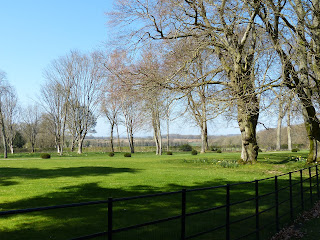Many great men have made their mark on Basingstoke, but it's a woman who'd achieved only a modest reputation by the time she died who stars on the signs marking the entrance to our borough.
Jane Austen's fame has grown exponentially since her death in 1817. If you're a foreign tourist making an effort to get to North Hampshire, there's a good chance she's the reason why. I've visited, and written before about, her house and museum at Chawton Cottage and her burial place at Winchester Cathedral. But I'd never made the effort to check out her birthplace at Steventon, just seven miles to the west of Basingstoke.It was an ideal objective for staycation exploration and lies just off a road that offers one of my favourite drives in the area. Turns out there are some pretty walks along it, too.
Calling Steventon a village is a stretch. It's a broadly-scattered collection of houses and farms just off the road that runs west from Basingstoke to Whitchurch (the B3400). The land here slopes gently down from the B3400 before starting to climb to a tree-lined ridge. From its top, you get a soothing view of the rolling hills and valleys, patch-worked with farm fields and woodland, that characterise this bit of England.
The house where Jane grew up no longer exists, but Steventon's high point ... both geologically and for tourism ... is the church where her father was vicar.
I can imagine her eyes tracing the patterns on the painted arch, watching dust motes dance in the pools of sunlight and letting her mind drift to making up stories about other villagers in other places.
There are memorials to her father, mother and brother, who followed in his father's parish footsteps, near the altar. But as with the memorials in Winchester Cathedral, it took fans from later generations to commemorate Jane's presence here.
Returning to the main road, you continue west to the pretty and much larger village of Overton. In Jane's day it was probably best known for being near the source of the River Test, and would have been the easiest place for her family to do a bit of shopping. Later in the 19th century its claim to fame was a mill that created the paper used for official government banknotes, now transformed into the Bombay Sapphire Distillery.
My usual destination on the B3400 lies a mile further west: Hardy's Cottage Garden Plants. But with my favourite nursery for herbaceous perennials still closed to the public, I decided to stop just short of it to take a look at something along the road that had always caught my eye.
Locals claim that the picturesque line of estate cottages at Freefolk comprise the longest continuous stretch of thatching in the country. Whether true or not, they're certainly make one of the most photogenic scenes in the local area.
And locals know it. They've even multiplied their charm by insisting on matching thatched bus stops out front.
Follow the brown sign to the Church of St. Nicholas, up a little lane across the road, for another treat. The old vicarage here is now a multi-million pound manor house beside the Test; the stuff lottery dreams are made of.
Tucked into the south flank of the property is the tiny, ancient church. Its foundations date from the 13th century but the exterior you see today is thanks to some remodelling at the time of William and Mary (early 1700s).
The interior has a peaceful simplicity
but also reminds you of the layers of history that build up in a place like this. Recent work has uncovered some early wall paintings of St. Christopher, probably whitewashed during the reformation.The most spectacular thing here, however, and delightful surprise in such a simple place, is the ornate tomb of Richard Paulet, son of the 2nd Marquess of Winchester.
After seeing the relatively simple family tombs in the church at the family seat in Old Basing, it was a surprise to find one of them lying in such isolated splendour.
A signboard outside reveals that there's a county-maintained trail linking 5 different mills along the Test, running from the Bombay Distillery at the Laverstoke Mill to the Silk Mill at Whitchurch.
Following it a short way from St. Nicholas' (where there's free parking just across the lane) takes you down to the main road, past the thatched estate cottages and into a riverside woodland so magical it reminded me of the famous moss-garden we visited in Japan. (Sadly the light at the time didn't allow me to get any decent pictures of it.)
Beyond that, a bridge crosses the test offering magnificent views, and just a few steps further on a cement weir that offers you a place to sit beside the river.
The same geography that makes North Hampshire's rivers clean, swift-flowing and exquisitely beautiful also makes them rare, ecologically fragile and home to prized brown trout. This means that most of the riverbanks are fenced off on inaccessible private land, jealously guarded for their fishing rights and zealously protected from polluters. This is one of the few places I've found where you could sit quietly beside the water, and I plan to be back. Next time, it will be with a picnic hamper, a chair and a watercolour set.I suspect not much has changed here since Jane Austen's day ... and I'd guess that's just the way the locals like it. I certainly do.



















No comments:
Post a Comment